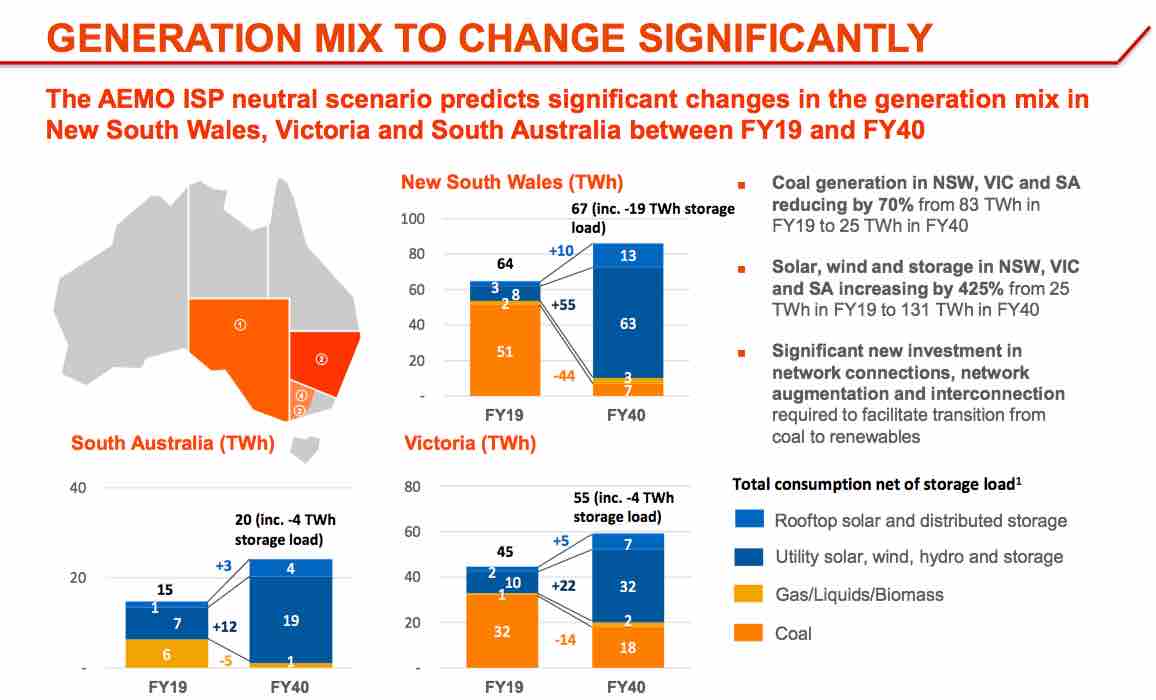“Our goal is that in the 2030’s, South Australia is a national and global force in reducing emissions by generating more clean power than needed for our domestic use.”
Van Holst Pellekaan sees this as an opportunity to decarbonise transport, the gas network (even if only by 10% initially) and then heavy industries. “It means green metals, green minerals and green hydrogen,” he said.
In reality, it is expected that the amount of fossil fuel generation will be minimal.
South Australia has already dumped coal, with the closure of its ageing and polluting plants in Port Augusta.
Gas currently accounts for nearly half of local generation needs, but Van Holst Pellekaan noted in his speech that the installation of four synchronous condensers (spinning generators that don’t burn fuel) will reduce the need for constant directions to gas generators to back up wind farms for system strength.
AEMO and the major transmission operator ElectraNet expect a similar result. Some high value gas will remain, but the need for gas to be switched on to deal with high levels of wind output will be largely removed by the synchronous condensers, and will lower costs significantly.
AEMO’s ISP forecasts suggests a share of around five per cent cent fossil fuel generation in South Australia’s grid by 2040 as gas is displace by battery storage and pumped hydro. As this graph above shows, some 95 per cent will come from utility-scale solar and wind, along with pumped hydro and battery storage, with more coming from rooftop solar and distributed storage.
The South Australia Liberal Party vision is remarkable for how it contrasts with its federal counterparts, the prevailing conservative view that renewables will kill the economy and a federal energy minister who insists there is already “too much” wind and solar in the system.
It also signals that the deployment of large scale wind and solar, along with storage in the form of batteries, pumped hydro and others, will actually accelerate in the coming ten years compared to the past decade.
The contribution of wind and solar to the state’s generation is already just over 50 per cent, and it will, of course, need to double its current deployment of wind and solar to get to a 100 per cent equivalent milestone, and even more to be “net renewables” with a significant amount of exports.
South Australia has a growing number of new projects lining up to join the grid. Close to another 100MW of solar is due to come on line by the end of the year at the Bungala solar farm, while Sanjeev Gupta is building the 280MW Cultana solar farm near Whyalla.
Gupta is supporting this with a big battery at Port Augusta, and a major pumped hydro scheme in the old iron pits in the Middleback ranges near Whyalla to provide green energy and revive the Whyalla steelworks and other major energy users.
And a whole queue of new projects are queuing to join the grid, particularly when the proposed new transmission link to Wagga Wagga is completed.
These include extensions to the newly opened Tailem Bend solar farm, as well as battery storage, a solar and battery storage addition to the Snowtown wind complex, the Twin Creek wind farm and battery storage project, and Neoen’s Crystal Brook wind and storage facility.
There are also a group of mega projects gathering around the proposed junction of the new interconnector at Robertstown, including the Bungama and the Solar River projects.
Van Holst Pellekaan says the state is keen to advance the storage components for the grid.
He noted that more than 50 different proposals had been received for the $50 million grid storage fund, including pumped hydro, grid batteries, distributed batteries, car batteries, thermal storage, gas storage, compressed air, and others.
The winners of that tender will be revealed in coming months, and he hinted that the “value stream” of batteries will be expanded after the experience of the Tesla big battery at Hornsdale.
That battery has stunned energy market players and institutions with its speed, accuracy and versatility, and its ability to puncture the local gas cartel.
But while it has delivered a handsome profit in its first year of operation, a large part of its potential is not valued by the market.
Van Holst Pellekaan also highlighted the success of the state’s two household battery programs, the government-financed Home Battery Scheme, which offers a subsidy of up to $6,000 per household, and the Tesla virtual power plant (VPP).
Van Holst Pellekaan said more than 3,000 households had committed to the two schemes this financial year, and market offerings are developing rapidly. Three battery assembly and manufacturing facilities – from sonnen, Alpha-ESS and Eguana – had also been established and agreed in the state with about 1,000 new jobs.
He also noted that demand management trials are also in final selection, and these will demonstrate how distributed resources- particular rooftop solar, where South Australia leads the world in per capita penetration – can be integrated in a way that reduces cost, unlocks liquidity, and empowers consumers.
“The successful trials will unlock the value of a two-way distribution system, and also address the challenges that will bring,” he said.
And, he noted, the impact of rooftop solar meant that “we’re no longer in a world where there is a baseload of demand with a predictable daily peak”, and because of this grids need to be smarter and more flexible, and new loads such as batteries and electric cars used to soak up supply at the right times.
- “That’s why electric vehicles will be another major focus area for us this year,” he said.
Source: RenewEconomy





